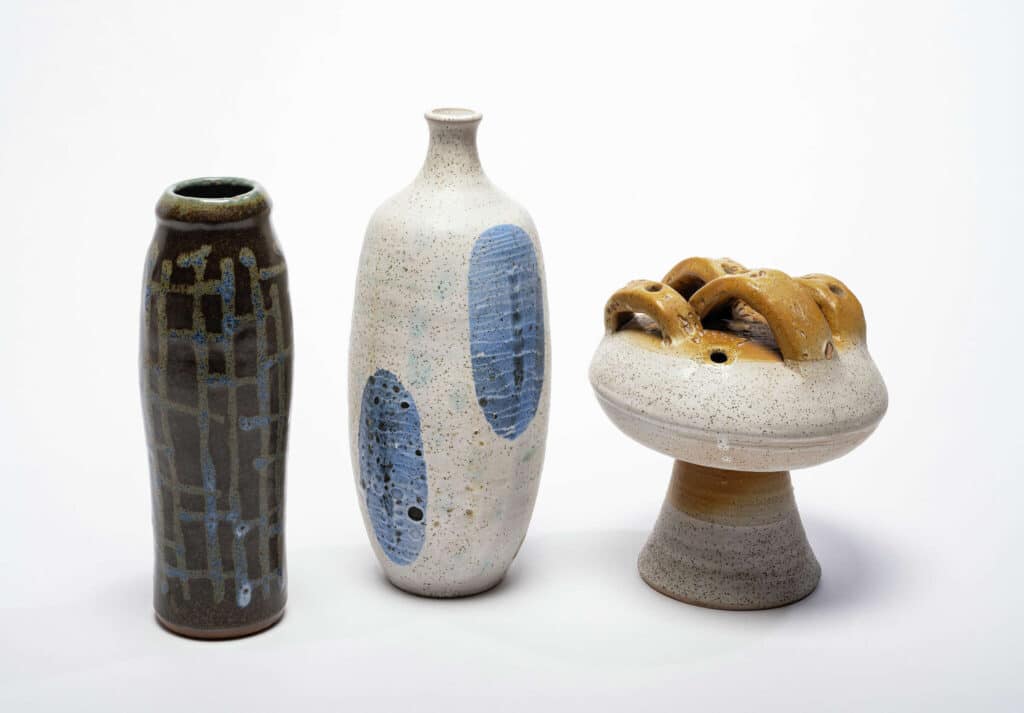Alma Rutgers | Greenwich Time | Nov. 26, 2023
It’s a must-see exhibition.
“Inspirational, Thank You.”
“Fantastic.”
“Simply Marvelous.”
“Such cool art!!! Can’t wait to come back.”
“Inspirational. How amazing that you uncovered this story in our own backyard.”
“Thank you for putting together such a fabulous show!!”
“I have a new appreciation for pottery. Thank you.”
These are just some of many statements that visitors have left in response to an invitation to share thoughts about the current Greenwich Historical Society exhibition: “Radical Pots and Cooperative Hands: Katherine Choy and Clay Art Center.”
The exhibition, which opened Oct. 18 and will be on view through Feb. 4, features the work of Katherine Choy, whose ceramic vessels broke traditional boundaries in the 1950s. Included in the presentation, in addition to her ceramic artwork, are photographs, letters, fliers, and other material.
Display cases are also devoted to the life and work of Henry Okomoto, a co-founder with Choy, of Clay Art Center in neighboring Port Chester, N.Y. The exhibition has been organized by the Greenwich Historical Society in partnership with Clay Art Center. The center has been a significant part of the American arts community for more than a half century.
When founded by Choy and Okomoto in 1957, Clay Art Center was one of the first cooperative studios in the United States dedicated to creative ceramic art, making Port Chester a destination for serious ceramic artists. This was at a time in the years following World War II when artistic studio pottery entered a new era of popularity, as explained in the exhibition. The teaching of ceramic art shifted from treatment as a manual skill to acceptance as art that’s akin to painting and sculpture.
Clay Art Center is today the largest ceramic facility in the tri-state area. It offers classes, workshops, lectures, and exhibitions that provide the public with an opportunity to experience the world of ceramics. Each year, it serves more than 25,000 people in person and awards more than 500 full and partial scholarships. It also provides studio space for working artists.
A leading figure, steeped in the non-conformist spirit of post-World War II 1950s, was ceramic artist Peter Voulkos (1924-2002). A reading corner in the exhibition room with table, chairs, and many books offers visitors an opportunity to learn more about this radical period in the history of ceramic art.
“I believe that the artist-potter should question life.” Katherine Choy’s quote from the March/April 1957 edition of Craft Horizons magazine is displayed at the exhibition’s start. “This requires a continuous breaking down and summarizing to express, to relate, to find one place and move with one’s own time, yet keep a universal entity.”
Born into a wealthy merchant family in Hong Kong in 1927, Choy spent her childhood in Shanghai. After her high school graduation, she came to study in the United States in 1946. She received a bachelor’s degree from Mills College in California in 1950 and a master’s degree in 1951, and then became head of the Newcomb College ceramics department at Tulane University in New Orleans.
In her mid-1950s New Orleans career, Choy was a national leader in the evolution of ceramics into expressive fine art.
At Mills College she met Henry Okamoto, a Japanese-American who was born and raised in the small town of Acampo outside Lodi, Calif. In 1942 Okamoto, age 20, and his family were forcibly removed from his home and incarcerated in a concentration camp in Arizona, where his sister died. His parents, reportedly, were never able to recover their land and property after their release from the camp.
Okamoto, like Choy, was a student of ceramic arts at Mills College.
In the early 1950s Okamoto relocated to Greenwich, presumably to be close to New York City for artistic reasons. In 1957, he was joined by Choy in founding Clay Art Center. Tragically, Choy died an untimely death in February 1958 at age 30, her obituary identifying the cause as undiagnosed pneumonia. This left Okamoto to continue building Clay Art Center as a go-to place for ceramic artists.
The exhibition’s many visitor “thank you” notes should belong to Maggie Dimock, curator of exhibitions and collections. It’s her artistic passion that’s made this “inspirational” exhibition possible.
